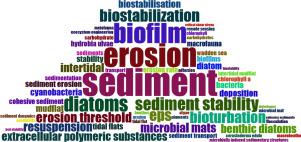Water Research ( IF 11.4 ) Pub Date : 2020-07-13 , DOI: 10.1016/j.watres.2020.116182 Sabine Ulrike Gerbersdorf 1 , Kaan Koca 1 , Dirk de Beer 2 , Arjun Chennu 3 , Christian Noss 4 , Ute Risse-Buhl 5 , Markus Weitere 5 , Olivier Eiff 6 , Michael Wagner 7 , Jochen Aberle 8 , Michael Schweikert 9 , Kristina Terheiden 1

|
Biofilm activities and their interactions with physical, chemical and biological processes are of great importance for a variety of ecosystem functions, impacting hydrogeomorphology, water quality and aquatic ecosystem health. Effective management of water bodies requires advancing our understanding of how flow influences biofilm-bound sediment and ecosystem processes and vice-versa. However, research on this triangle of flow-biofilm-sediment is still at its infancy. In this Review, we summarize the current state of the art and methodological approaches in the flow-biofilm-sediment research with an emphasis on biostabilization and fine sediment dynamics mainly in the benthic zone of lotic and lentic environments. Example studies of this three-way interaction across a range of spatial scales from cell (nm – µm) to patch scale (mm – dm) are highlighted in view of the urgent need for interdisciplinary approaches. As a contribution to the review, we combine a literature survey with results of a pilot experiment that was conducted in the framework of a joint workshop to explore the feasibility of asking interdisciplinary questions. Further, within this workshop various observation and measuring approaches were tested and the quality of the achieved results was evaluated individually and in combination. Accordingly, the paper concludes by highlighting the following research challenges to be considered within the forthcoming years in the triangle of flow-biofilm-sediment: i)
Establish a collaborative work among hydraulic and sedimentation engineers as well as ecologists to study mutual goals with appropriate methods. Perform realistic experimental studies to test hypotheses on flow-biofilm-sediment interactions as well as structural and mechanical characteristics of the bed.
ii) Consider spatially varying characteristics of flow at the sediment-water interface. Utilize combinations of microsensors and non-intrusive optical methods, such as particle image velocimetry and laser scanner to elucidate the mechanism behind biofilm growth as well as mass and momentum flux exchanges between biofilm and water. Use molecular approaches (DNA, pigments, staining, microscopy) for sophisticated community analyses. Link varying flow regimes to microbial communities (and processes) and fine sediment properties to explore the role of key microbial players and functions in enhancing sediment stability (biostabilization).
iii) Link laboratory-scale observations to larger scales relevant for management of water bodies. Conduct field experiments to better understand the complex effects of variable flow and sediment regimes on biostabilization. Employ scalable and informative observation techniques (e.g., hyperspectral imaging, particle tracking) that can support predictions on the functional aspects, such as metabolic activity, bed stability, nutrient fluxes under variable regimes of flow-biofilm-sediment.
中文翻译:

探索流-生物膜-沉积物的相互作用:评估当前状况和未来挑战。
生物膜活动及其与物理,化学和生物过程的相互作用对于各种生态系统功能至关重要,影响水文地貌,水质和水生生态系统健康。对水体的有效管理要求加深我们对水流如何影响结合生物膜的沉积物和生态系统过程的理解,反之亦然。但是,对这种流动生物膜沉积物三角形的研究仍处于起步阶段。在这篇综述中,我们总结了流动生物膜沉积研究的最新技术和方法,重点是在水和胶体环境的底栖区域中的生物稳定和精细的沉积动力学。鉴于迫切需要跨学科的方法,着重研究了从细胞(nm – µm)到斑块规模(mm – dm)的整个空间尺度上的这种三向交互作用的示例研究。作为对此次审查的贡献,我们将文献调查与在联合研讨会的框架内进行的试点实验的结果相结合,以探讨提出跨学科问题的可行性。此外,在该车间内,对各种观察和测量方法进行了测试,并对所获得结果的质量进行了单独或组合评估。因此,本文通过重点介绍了未来几年在流动生物膜沉积三角关系中应考虑的以下研究挑战:作为对此次审查的贡献,我们将文献调查与在联合研讨会的框架内进行的试点实验的结果相结合,以探讨提出跨学科问题的可行性。此外,在该车间内,对各种观察和测量方法进行了测试,并对所获得结果的质量进行了单独或组合评估。因此,本文通过重点介绍了未来几年在流动生物膜沉积三角关系中应考虑的以下研究挑战:作为对此次审查的贡献,我们将文献调查与在联合研讨会的框架内进行的试点实验的结果相结合,以探讨提出跨学科问题的可行性。此外,在该车间内,对各种观察和测量方法进行了测试,并对所获得结果的质量进行了单独或组合评估。因此,本文通过重点介绍了未来几年在流动生物膜沉积三角关系中应考虑的以下研究挑战:在该研讨会中,对各种观察和测量方法进行了测试,并对所获得结果的质量进行了单独或组合评估。因此,本文通过重点介绍了未来几年在流动生物膜沉积三角关系中应考虑的以下研究挑战:在该研讨会中,对各种观察和测量方法进行了测试,并对所获得结果的质量进行了单独或组合评估。因此,本文通过重点介绍了未来几年在流动生物膜沉积三角关系中应考虑的以下研究挑战:
在水利和泥沙工程师以及生态学家之间建立协作关系,以采用适当的方法研究共同目标。进行现实的实验研究,以检验关于流-生物膜-沉积物相互作用以及床的结构和机械特性的假设。
ii)考虑沉积物-水界面处流动的空间变化特征。利用微传感器和非侵入式光学方法(例如颗粒图像测速仪和激光扫描仪)的组合来阐明生物膜生长背后的机理,以及生物膜与水之间的质量和动量通量交换。使用分子方法(DNA,色素,染色,显微镜)进行复杂的社区分析。将不同的流态与微生物群落(和过程)和精细的沉积物特性联系起来,以探索关键的微生物角色和功能在增强沉积物稳定性(生物稳定)中的作用。
iii)将实验室规模的观测结果与与水体管理有关的更大尺度联系起来。进行野外实验,以更好地了解可变流量和沉积物制度对生物稳定的复杂影响。使用可扩展且信息丰富的观察技术(例如,高光谱成像,粒子跟踪),可以支持功能方面的预测,例如代谢活动,床的稳定性,流动生物膜沉积物在各种情况下的营养通量。











































 京公网安备 11010802027423号
京公网安备 11010802027423号